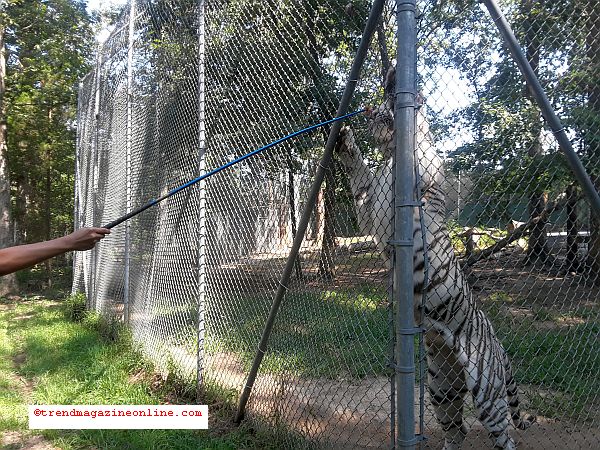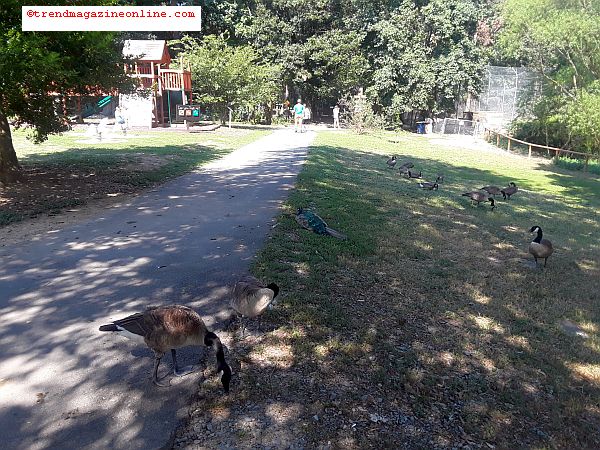
The next area of the park proved to be the
most challenging in that in order to get to through it safely required me to
engage in a phenomenon known as the
"Colorado Quick Step." This walking
technique is deployed when walking through any area where
Canada Geese inhabit.
It involves making
quick steps around each package that is left behind
one of those northern fowls. As such, I was enthralled to see one of the park
staff members assisting us by clearing the way with a broom. I considered his
job
the most important at
Tiger
World.
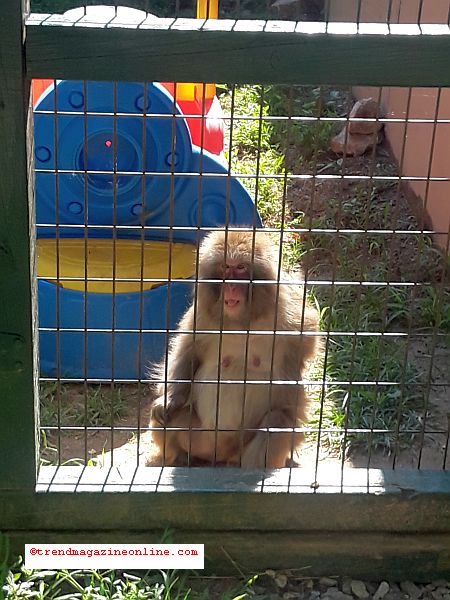
Next up was these light brown red-faced
tailless monkeys known as
Snow monkeys or
Japanese Macaque
(Macaca fuscata). As their name suggest, they are found in areas of
Japan
and are particularly fond of warm hot springs. Conversely, they live in places
where the temperature can drop below zero degrees. I really enjoyed feeding
them from my cup purchased from the gift shop at the beginning of my visit and
they enjoyed finding and eating my treats. I could not help but notice that one
of them
kept reaching behind to his/her
rear while snacking on my peanuts. We would consider that a bit ill-mannered
in our human world but in their animal world it seems to be quite the
acceptable behavior. The males can live up to
27 years in captivity
while the females typically live
6 years in the wild and they are listed
as an endangered species.
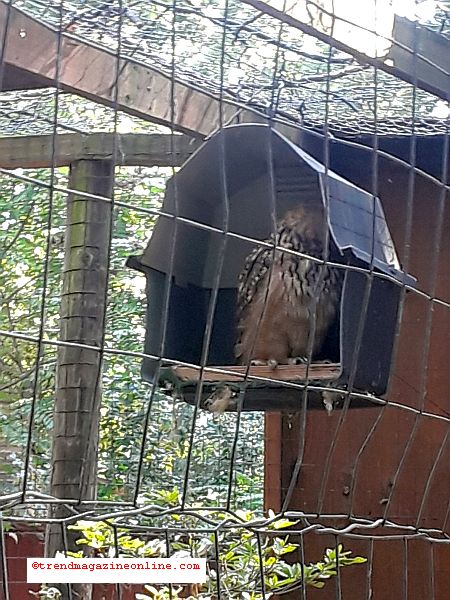
Next up was the
biggest owl that I have personally seen
up until this point in my life. It is called a
Eurasian/European Eagle owl
(Bubo Bubo) and has a wing span of nearly six feet which qualifies it to play
defense in the
NBA -- perhaps as a free agent.
Smile! These owls
are found in
Africa,
Asia,
Europe, and the
Middle East
and the females are typically larger than the males.
Yikes! I have
actually seen an owl in the wee hours of the morning while living off
Central
Avenue in
Charlotte,
NC, and at first glance it took my
breath away as a much unexpected encounter. It is my understanding that this
magnificent fowl have keen eyesight and prefer to hunt at night. As such, I
made sure that I kept my distance and eye on that curious bird.

This next area solved my dilemma in terms of
what to do with the remaining food in my feed cup as I was nearing the end of the
park and did not want to discard my perfectly good snacks. The pond to my left
was filled with all sorts of feathered fowl to include one that stood out in
the crowd due to its size and color. The
White (Mute)
swan
(Cygnus olor) and can be found in many countries throughout
Asia and
Europe
and in the
1800's were introduced to areas of
Canada and the
United
States.
These angelic-looking birds
can reach a length of five feet and have a wing span of up to seven feet which
also qualifies them to play defense in the
NBA. I became an immediate
hit here because
I had the goods/eats
that these birds loved to snack on while providing me with excellent photo opts
to include in this article. Not to be outdone, they also have these beautiful
Black swans that inhabit the same pond.
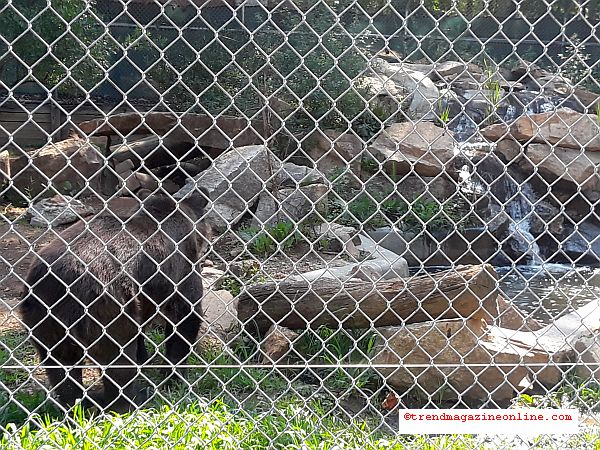
Next up completed the all-endearing cliche' of
"Lions, and Tigers, and Bears," for me as I have previously covered the
first two in this three segment piece on
Tiger World. My next skip along
"The yellow brick road" brought me to the bear area of the park where
at first glance this guy was hard to spot
as it blended in with its environment; just like in the wild. This beast had
one of the most impressive domiciles which included a stream, rocks, and logs.
The only missing element was salmon jumping down the waterfall on their journey
to mate. It was still a quite pleasant site despite the lack of that bear
necessity.
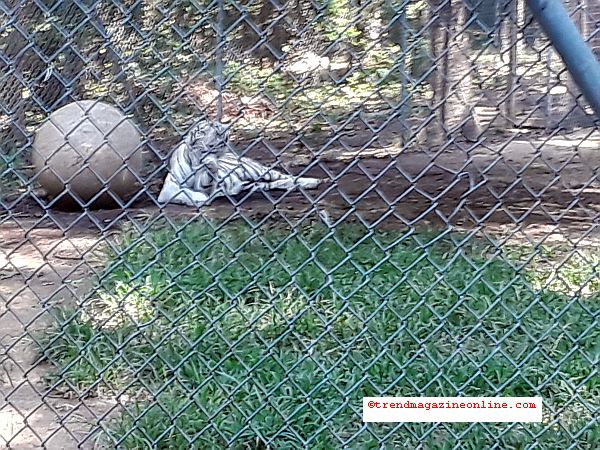
I ventured into this last area expecting to
mingle with other park guests; however, found myself alone with several
white tigers -- in their sparse cages
of course. I was drawn to the end of the path by the repeated sound of one of them
roaring continuously every few minutes. It was not quite clear to me as to the
reason for the
repetitive loud beastly
noise emanating from the end of this path, so I quickly scampered back to
the beginning just in case it was a warning signal for me to not be in that
area at that particular time. On my way back I caught this Bengal tiger by the
name of
Shirkahn taking a late
morning nap which, according to staff, was their favorite time to snooze. I was
elated to find that other guests had begun to populate this area along with
those very
brave female staff members
who, as I mentioned in segment one, deserve a raise for feeding these big cats.
On that note they were at it again in this section but this time they were
coaching visitors to feed these phenomenal
cats that stand over ten feet tall on their hind legs.
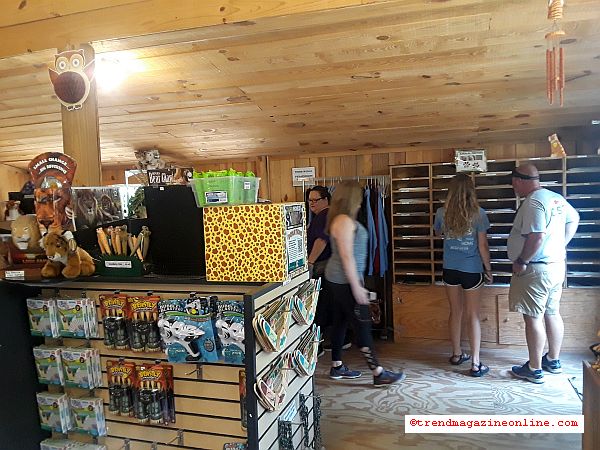
I left this area with a new sense of respect
and awe for these big cats as well as all of the other wonderful beasts that
God
created
"In the beginning" of our planet. In addition, I am so thankful
that these animals are being protected and preserved from those bad human beings
that are of the mind set that they were place here simply for the challenge of
being hunted, slaughtered, and mounted to fulfill their shallow egos and useless
bragging rights. It does not in the least impress me to see these creatures
mounted on someone's wall; however, I am quite impressed to see them alive and
well even if behind a cage in a safe environment. My last stop was once again
their gift shop before exiting this wonderful zoo/park/preserve for our future
generations to enjoy.
Well folks, that does it for my final part three of this
review of
Tiger World in
Rockwell,
NC. Check back next
month for more exciting articles. Remember to
"like" our
Facebook page to be notified when additional
articles are published.
<<<Back To Part II
<<<Back To Part I
If you would like to schedule a group visit to
Tiger World click here for a quote!

